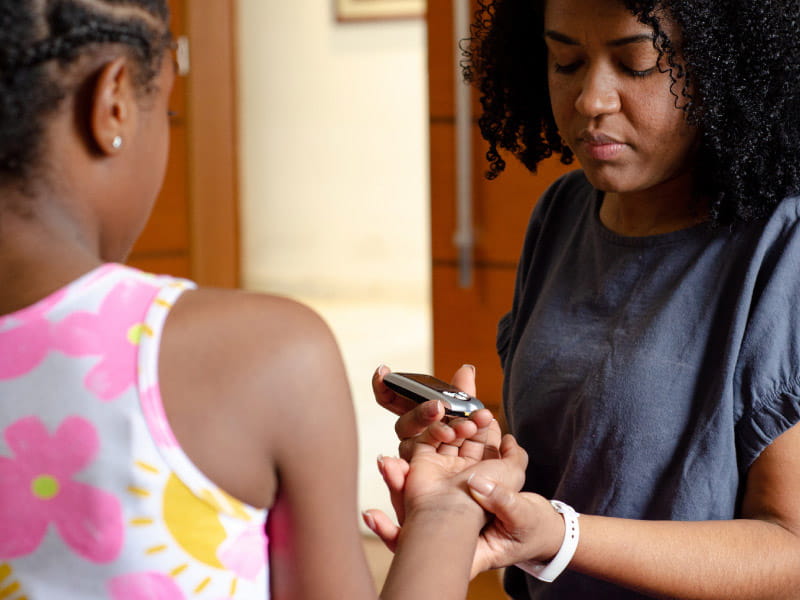How is diabetes a risk factor for cardiovascular disease?
Black and Hispanic kids with Kind 1 diabetes are extra doubtless than their white friends to develop stiffened arteries – a precursor to coronary heart illness and stroke – through the first decade of their diabetes analysis, new analysis finds.
“That provides us hope that there are issues we will attempt to modify, issues we will attempt to enhance,” stated lead examine writer Katherine Sauder, an affiliate professor and deputy director of the Life Course Epidemiology of Adiposity and Diabetes (LEAD) Middle on the College of Colorado Faculty of Public Well being in Aurora.
Blood flows a lot sooner alongside stiff arteries. The elevated circulation and stress of blood can negatively have an effect on organs equivalent to the center. Artery stiffness usually develops in older adults however can even happen in folks with Kind 1 diabetes, a illness characterised by the physique’s incapability to supply sufficient insulin. Such a diabetes is most frequently recognized throughout childhood, although it might happen at any age.
Individuals who have Kind 1 diabetes are about 10 occasions extra prone to develop heart problems than those that haven’t got it. But analysis into the prevention of heart problems in folks with Kind 1 diabetes has been restricted, and what little there may be has targeted largely on white folks. In the meantime, the incidence of Kind 1 diabetes within the U.S., which has been rising about 2% annually since no less than the early 2000s, is rising at an excellent sooner fee amongst Hispanic and Black populations.
Within the new examine, researchers analyzed information for a racially various group of 1,162 kids and younger adults within the SEARCH for Diabetes in Youth examine, which recruited members from South Carolina, Ohio, Colorado, Washington and southern California. The youngsters had been a median 9 years outdated on the time they had been recognized with Kind 1 diabetes and enrolled within the examine. Carotid femoral pulse wave velocity, thought-about the gold commonplace measurement of arterial stiffness, was taken after a median 11 years of follow-up.
The evaluation discovered increased ranges of artery stiffness in Black and Hispanic younger folks, with the largest hole between Black and white members. Black members had 10% increased charges of artery stiffness than white members.
“That sounds small, however these individuals are of their 20s,” stated Sauder, who famous that heart problems usually would not seem till an individual’s 50s. “The priority is that this hole goes to proceed rising. If we will determine why this distinction is, maybe we will intervene now and perhaps there’s an opportunity to reverse the variations which have constructed up within the first 10 years of their illness.”
Whereas there additionally was a spot within the charges of artery stiffness between Hispanic and white younger adults with Kind 1 diabetes, that disparity largely disappeared when the researchers managed for cardiovascular and socioeconomic threat components. One of many greatest modifiable components was entry to diabetes medicines. One other was being obese.
“If we might get Hispanic members to have the identical cardiovascular threat profile as their white friends, blood circulation would decelerate by 15%,” Sauder stated. “If we might get them to have the identical financial profile, it could decelerate by 27%.”
Controlling for these components, nonetheless, didn’t erase the disparities between Black and white members.
“It doesn’t matter what components we checked out, we might solely get the distinction to lower about 21%,” Sauder stated. “That tells us there are different issues occurring past A1C and BMI and with the ability to pay to your medicines. There are different issues driving this.”
The brand new analysis “presents perception into what is likely to be altering in cardiovascular well being within the earlier many years of life for folks with Kind 1 diabetes,” stated Dr. Risa Wolf, director of the Pediatric Diabetes Middle and an affiliate professor on the Johns Hopkins Hospital in Baltimore. Wolf was not concerned within the examine.
Understanding what’s driving these disparities might assist goal crucial interventions, she stated.
“The extra you possibly can interact folks in care early on, by rising entry to care, adherence to medicines and extra constant follow-up care, the extra we might be able to forestall poor cardiovascular outcomes later in life,” Wolf stated.
One factor the brand new examine didn’t examine was how structural racism and the stress it might trigger may impression well being, Sauder stated.
One other issue that might be necessary is using superior diabetes applied sciences, equivalent to steady glucose screens and insulin pumps, to handle blood glucose ranges, Wolf stated. When blood glucose ranges will not be correctly managed, the chance for heart problems will increase. Latest research, together with one Wolf was concerned with, have discovered important racial disparities within the prescription and use of those units amongst kids and adults.
However Sauder stated even when superior diabetes applied sciences are used, some racial disparities in blood glucose management stay. “It could be nice if there was a simple reply, however it’s extra sophisticated than that,” she stated.







